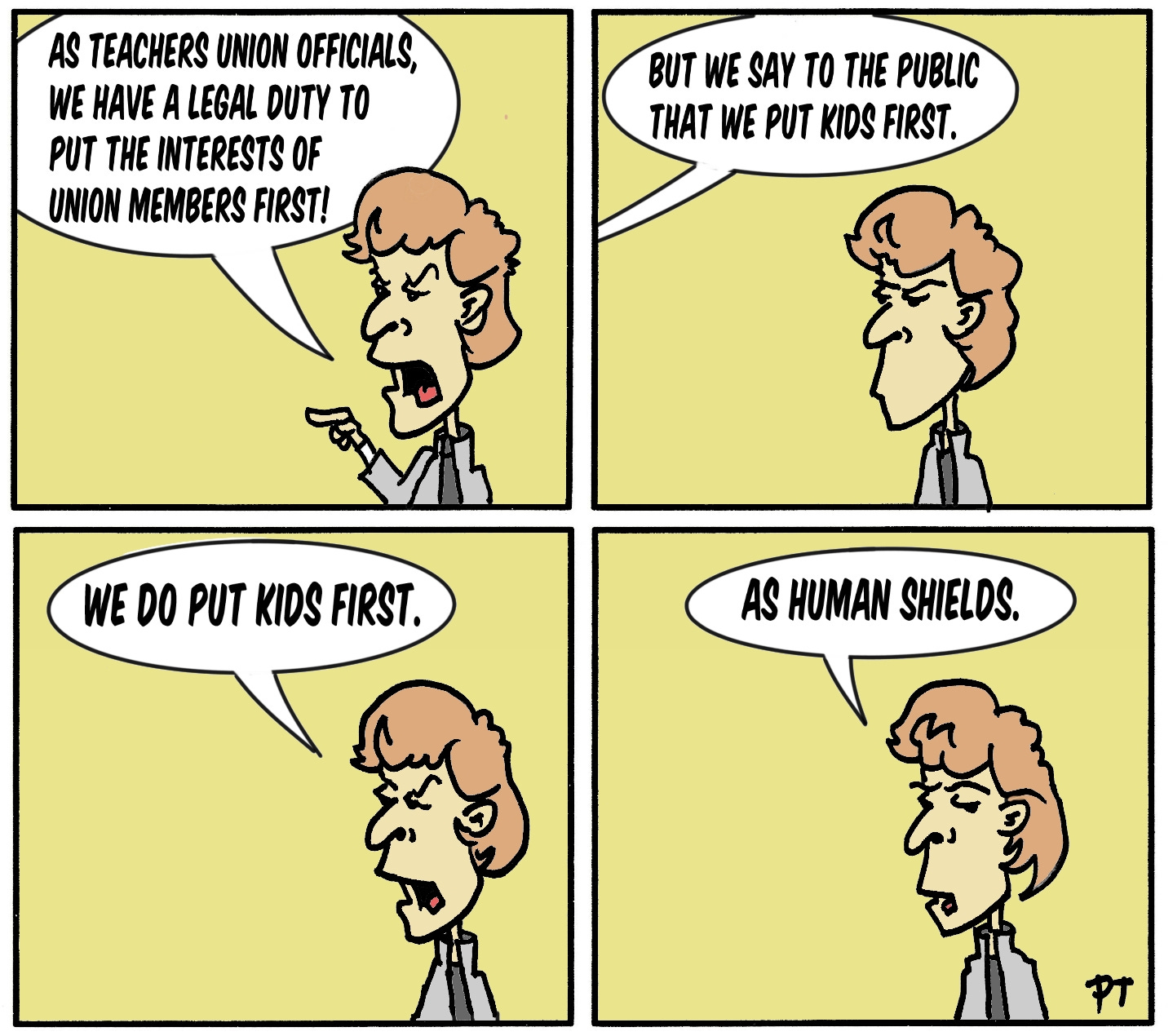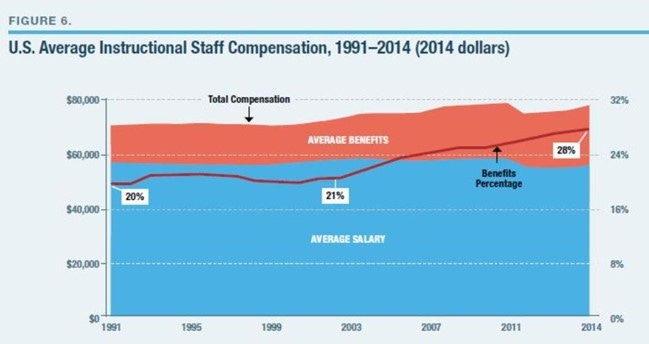The teachers my kids have had in public school have been wonderful, and it’s been a joy to see them teach.
Individual teachers, however, are wholly separate and apart from teachers’ unions, which are organizations with legally-binding institutional duties to the members of the organization. And students, of course, are excluded from membership in unions.
The Labor-Management Reporting and Disclosure Act, for example, makes clear in section 501(a) that “The officers, agents, shop stewards, and other representatives of a labor organization occupy positions of trust in relation to such organization and its members as a group. It is, therefore, the duty of each such person, taking into account the special problems and functions of a labor organization, to hold its money and property solely for the benefit of the organization and its members …” Such union officials also have the duty “to refrain from dealing with such organization [the union] as an adverse party or in behalf of an adverse party in any matter connected with his duties.” Each of these obligations is considered a “fiduciary duty,” and if any senior union official violated them, they could be sued. What this means is that if a teachers union official ever actually did put the interests of children and children’s education before the union members’ interests in better wages and work benefits, that teachers union official could be sued, and be legally stripped of their position as a result.
So teachers unions don’t actually put children and their education “first” because they have a legal duty to put their members first.
Teachers unions still go ahead and falsely claim their policy positions would put children first, but they make those claims to further their primary (fiduciary) duty of achieving increased wages and benefits for union members. And while consumer protection laws generally prohibit businesses from lying in material ways about their products to consumers, teachers unions aren’t covered by those laws because teachers unions aren’t considered businesses and public school children and their parents aren’t considered “consumers.” So, as it turns out, teachers unions have not only a license to mislead about their interest in children, but also a duty to mislead about their interest in children, since by couching their policies in children-centered rhetoric teachers unions help fulfill their fiduciary duty to achieve greater wages and benefits for their own members. I’m not being cynical here. It’s the law.
Teachers unions, as do other political actors, also have an incentive to promote policies that are superficially attractive but will ultimately fail because those policies provide yet another form of job security for union officials. If the policies they promoted tended to succeed, and problems were solved, it would be more difficult for them to promote alternative policies in future elections. It’s easier to run on a platform of “fixing the system” when the system remains perpetually broken.
A summary of research on improving teaching outcomes found that some of the most expensive proposed solutions (which are generally supported by teachers unions, such as reducing class size) are actually among the least effective, as shown in the chart below.
Regarding the results of teachers union collective bargaining on kids’ future job prospects, the first analysis of the effect of teacher collective bargaining on long-run labor market and educational attainment outcomes by researchers at Cornell suggests that teachers union collective bargaining worsens the future labor market outcomes of students. As the researchers write:
Our estimates suggest that teacher collective bargaining worsens the future labor market outcomes of students: living in a state that has a duty-to-bargain law for all 12 grade-school years reduces earnings by $800 (or 2%) per year and decreases hours worked by 0.50 hours per week. The earnings estimate indicates that teacher collective bargaining reduces earnings by $199.6 billion in the US annually. We also find evidence of lower employment rates, which is driven by lower labor force participation, as well as reductions in the skill levels of the occupations into which workers sort. The effects are driven by men and nonwhites, who experience larger relative declines in long-run outcomes.
The researchers’ bottom line is that “We find strong evidence that teacher collective bargaining has a negative effect on students’ earnings as adults.”
The study compared outcomes for students in states that mandate collective bargaining before and after the collective-bargaining requirement was imposed to outcomes for students over the same period in states that did not require collective bargaining. It also adjusted for the share of the student’s state birth cohort that is black, Hispanic, white and male. Students who spent all 12 years of their elementary and secondary education in schools with mandatory collective bargain earned $795 less per year as adults than their peers who weren’t in such schools. They also worked on average a half hour less per week, were 0.9% less likely to be employed, and were in occupations requiring lower skills. The authors found that these factors added up to an overall loss of $196 billion per year for students educated in the 34 states with mandated collective bargaining.
Teachers unions also have a poor track record of helping teachers themselves. Researchers have found that:
Teacher pension systems are not only expensive; their structures are inequitable and misguided. Roughly 75% of teachers will be net losers from their pension plan because they will quit or change school districts before they have reached the minimum years of service to be eligible to receive a pension; or they will retire or leave the system before their contributions and the interest earned on them are more than the pension for which they then qualify. Even the winners in this pension lottery—the roughly 25% of teachers who remain on the job in the same system long enough to earn substantial retirement benefits—will have traded years of lower salaries in exchange for disproportionately large retirement benefits.
Also, groups that claim to promote educational reform, including teachers unions, are overwhelmingly dominated by supporters of the Democratic Party, which today is most prominently allied with the teachers unions. As Frederick Hess points out:
Today's education debates are dominated by voices well to the left of the nation as a whole. Although the ideological views of K-12 teachers broadly reflect those of the nation, this is decidedly not the case when it comes to teachers' union leadership, college faculty, administrators, advocates, and funders. Even the once-bipartisan world of K-12 reform has taken on a deep blue hue, with a 2019 analysis finding that staff at more than 200 major school-reform organizations support Democratic candidates and causes over their Republican counterparts by better than a nine-to-one margin (about the same ratio as teachers' unions do, in fact).
The official positions of teachers unions, which are the same positions reflected in Democratic elected officials’ policies, don’t even reflect the education policy views of rank-and-file Democrats themselves. According to a survey by Education Next, run by two Harvard professors, in contrast to Democratic Party policies, 80% of rank-and-file Democrats who took a position on the issue said they backed the federal requirement that “all students be tested in math and reading each year,” with only 20% disagreeing. (Republicans had similar responses: 74% and 26%, respectively.) As for punishing and rewarding teachers, 57% of Democrats nationwide said they supported “basing part of the salaries of teachers on how much their students learn.” Fifty-nine percent said teacher tenure should be eliminated. Also, 61% of Democrats around the country oppose federal policies that “prevent schools from expelling and suspending black and Hispanic students at higher rates than other students.” (So do 86% of Republicans, and a majority of both African-American and Hispanic respondents who take a side.)
These are anomalous outcomes, but then again the very creation of unions as separate legal entities in America may well have been a fluke in itself. Frances Perkins was the first female Cabinet Secretary who ran the Labor Department under President Franklin D. Roosevelt. She was also the lead federal official behind the major New Deal legislation. In her biography of Frances Perkins, The Woman Behind the New Deal: The Life of Frances Perkins, FDR’s Secretary of Labor and His Moral Conscience, Kirstin Downey describes how the federal law recognizing unions as exclusive bargaining units grew haphazardly out of President Franklin Delano Roosevelt’s National Recovery Act, which created a “bizarre corporate-state scheme, with the government as puppet master.” As Downey writes:
[Nelson] Slater began collaborating with [General] Johnson, seeing the NRA [National Recovery Act] and industrial cooperation as a potential solution to textile industry woes. Textiles became the first of many industries to undergo the process of obtaining government approval for a wage and hour code … Frances wanted to give workers a formal place at the table in this new orchestrated arrangement between government and employers. Johnson and Slater were paternalistically attentive to workers’ welfare, but they considered it ridiculous to include labor representatives in the negotiations. Even Frances agreed that the existing textile union, the skeletal United Textile Workers, was a ‘set of lunatics and grafters,’ and many of the other unions were too feeble to be effective. So Frances suggested they set up a labor advisory committee. With the backing of the AFL [the American Federation of Labor], Frances appointed the labor representatives and found substitutes if no legitimate unions could be found to represent worker interests. In this way, the right of unions to organize originated in the NRA bill, and almost by accident. In drafting the legislation, Frances and Richberg decided to insert language to ensure a role for the workingman in the talks, wording that would permit workers to organize into unions more easily.
So the next time you read a policy position of a teachers union official, remember that while they may say they put kids and kids’ education first, they won’t actually do that in practice because putting kids first would violate their own fiduciary duty to put the interests of their own union members first. The promotion of that duty is the sole reason unions exist in the first place.





